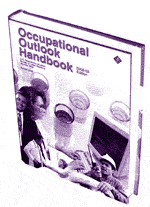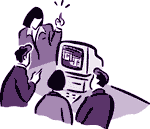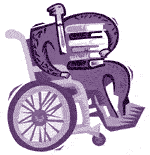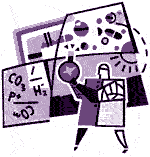|
|
Spring
2002 Vol. 46, Number 1
|
Grab Bag
|
 Download the PDF
(170K)
Download the PDF
(170K)
Grab Bag from past issues
|
New occupations in the Handbook
The 2002-03 edition of the Occupational Outlook
Handbook, released online in December, includes several occupations not covered in previous editions. Every edition of the Handbook features a few new occupations, but the latest edition introduced about 20—the largest number in the Handbook’s recent history. Many of these made their debuts as articles in the
OOQ.
Several of the new occupations—such as desktop publisher and systems analyst and database
administrator—were once part of other occupational statements. Now,
standing alone, they are described in more detail.
Others—including biomedical engineer, probation officer, and customer service representative—are analyzed for the first time.
And many of those with smaller employment numbers—such as massage therapist and health educator—are in a special section of the Handbook for occupations not studied in detail. once part of other occupational statements. Now,
standing alone, they are described in more detail.
Others—including biomedical engineer, probation officer, and customer service representative—are analyzed for the first time.
And many of those with smaller employment numbers—such as massage therapist and health educator—are in a special section of the Handbook for occupations not studied in detail.
Why are there so many new occupations in the Handbook? The Bureau of Labor Statistics gathered more data on these occupations after it switched to the new Standard Occupational Classification System.
Visit the your local library or career counseling office to discover the tasks, earnings, training requirements, and employment prospects of new arrivals and old favorites in the 2002-03 Handbook or to learn more about the new classification system in the fall 1999 issue of the OOQ. You may also visit the Handbook online at
http://www.bls.gov/oco; an OOQ archive is also accessible online at
http://www.bls.gov/opub/ooq/ooqhome.htm.
And see data on more newly studied occupations in the Occupational Employment Survey, online at
http://www.bls.gov/oes. This survey provides data on many occupations whose employment numbers are too small to permit their inclusion in the Handbook.
 Top
Top
|
Help for starting a mentoring program
Mentors can be crucial in a student’s transition from school
to career. But how do schools start and run mentoring programs
and find qualified volunteers to participate? Technical
assistance packets from the National M entoring Center answer
those and other mentoring-related questions. entoring Center answer
those and other mentoring-related questions.
The Center, funded in part by the U.S. Department of Justice,
offers six assistance packets. “The ABC’s Of School
Mentoring” is a 100-page guide for developing and running a
program. Another packet tackles mentor recruitment through
step-by-step advice for targeting, planning, and implementing a
recruitment drive. Other topics include training and oversight
of mentors and helping mentors relate to students.
Each packet provides checklists, worksheets, and sample forms
and ends with a list of resources.
For a copy of the packets, call 1 (800) 547-6339, ext. 135. Or,
write the Northwest Regional Educational Laboratory, National
Mentoring Center, 101 SW. Main St., Suite 500, Portland, OR
97204. To view the packets online, visit http://www.nwrel.org/mentoring/packets.html.
 Top
Top
|
Resources for students with disabilities
How to find money for college and what to consider when choosing a school are just two of the many topics covered in publications from HEATH Resource Center, the American Council on Education’s National Clearinghouse on Postsecondary Education for Individuals with Disabilities. Postsecondary Education for Individuals with Disabilities.
HEATH offers several free publications filled with advice for postsecondary students, counselors, teachers, and administrators. “The Guide to Financial Aid for Students with Disabilities” is one of the most popular. This packet describes Federal aid and its relationship to State vocational rehabilitation grants; it also lists other disability-related grants and scholarships.
To receive free copies of HEATH publications, call 1 (800) 544-3284 or write 2134 G St. NW., Washington, DC 20052. To view online versions, visit the HEATH Web site,
http://www.heath-resource-center.org.
 Top
Top

Earth work: Careers in the natural sciences
Do you know how natural scientists responded to recent natural disasters, from rockslides in Yosemite National Park to volcanoes in the Philippines? An article describing
wha t those scientists did is part of a newsletter, “Scientists in Action!,” from the U.S. Geological Survey. Additional articles depict the work of biologists, geologists, cartographers, and other scientists—exploring the ocean floor, preparing dinosaur bones for display, and solving the mystery of three-legged frogs, for example. t those scientists did is part of a newsletter, “Scientists in Action!,” from the U.S. Geological Survey. Additional articles depict the work of biologists, geologists, cartographers, and other scientists—exploring the ocean floor, preparing dinosaur bones for display, and solving the mystery of three-legged frogs, for example.
The newsletter, with 15 oversized, full-color pages, gives readers a glimpse of natural sciences careers, especially those with the Federal Government. For a free copy of “Scientists in Action!,” call 1 (888) 275-8747 or write USGS Information Services, PO Box 25286, Denver, CO 80225.
 Top
Top

OOQ: Subscribe online
Now, requesting a subscription to the Occupational Outlook Quarterly (OOQ) is as easy as clicking your mouse.
At the Government Printing Office’s secure online bookstore,
http://bookstore.gpo.gov, you can order the OOQ and most other Federal Government publications. You’ll need your VISA, MasterCard, Discover/Novus, or American Express card number and expiration date.
If you prefer, you may still order the OOQ by phone, fax, or mail. Call (202) 512-1800, fax (202) 512-2250, or send the order to: Superintendent of Documents, PO Box 371954, Pittsburgh, PA 15250-7954. For your convenience, there’s an order card in every issue of the OOQ.
|
|
|



